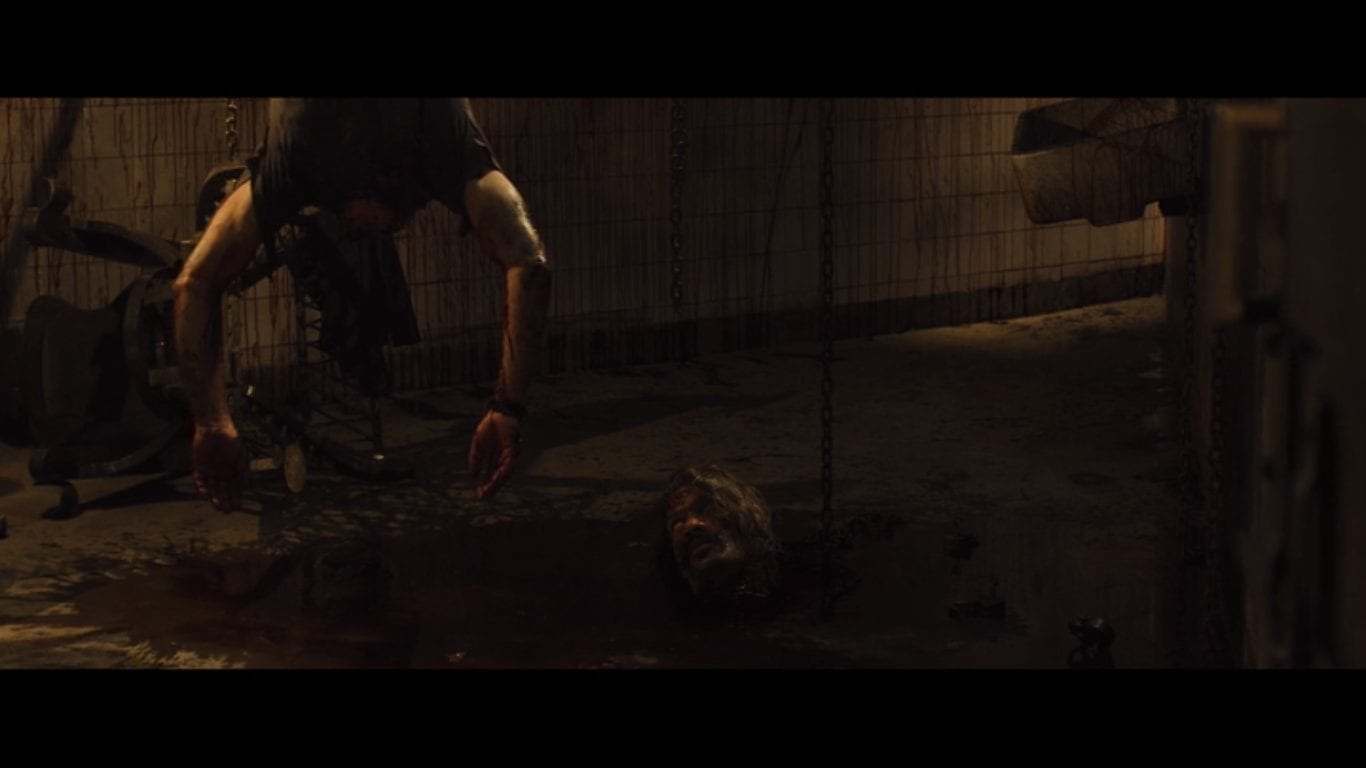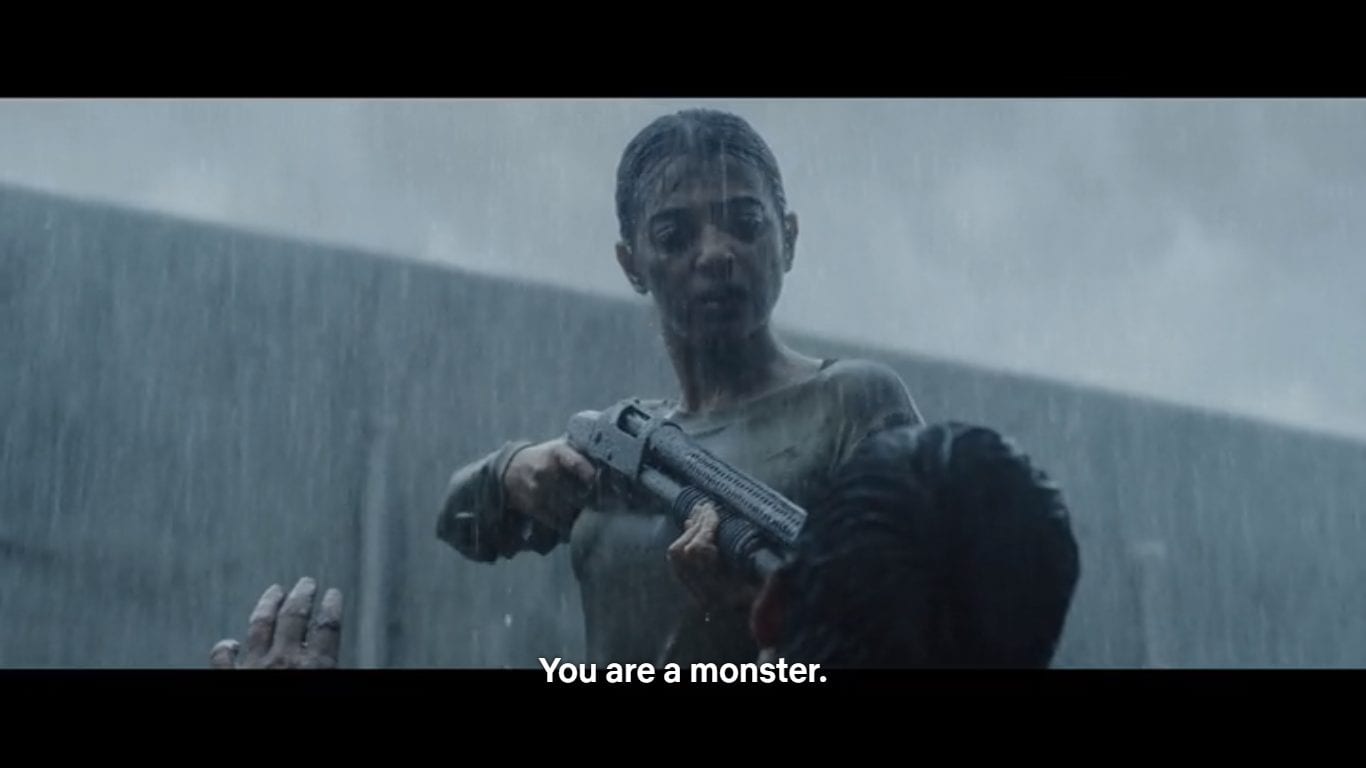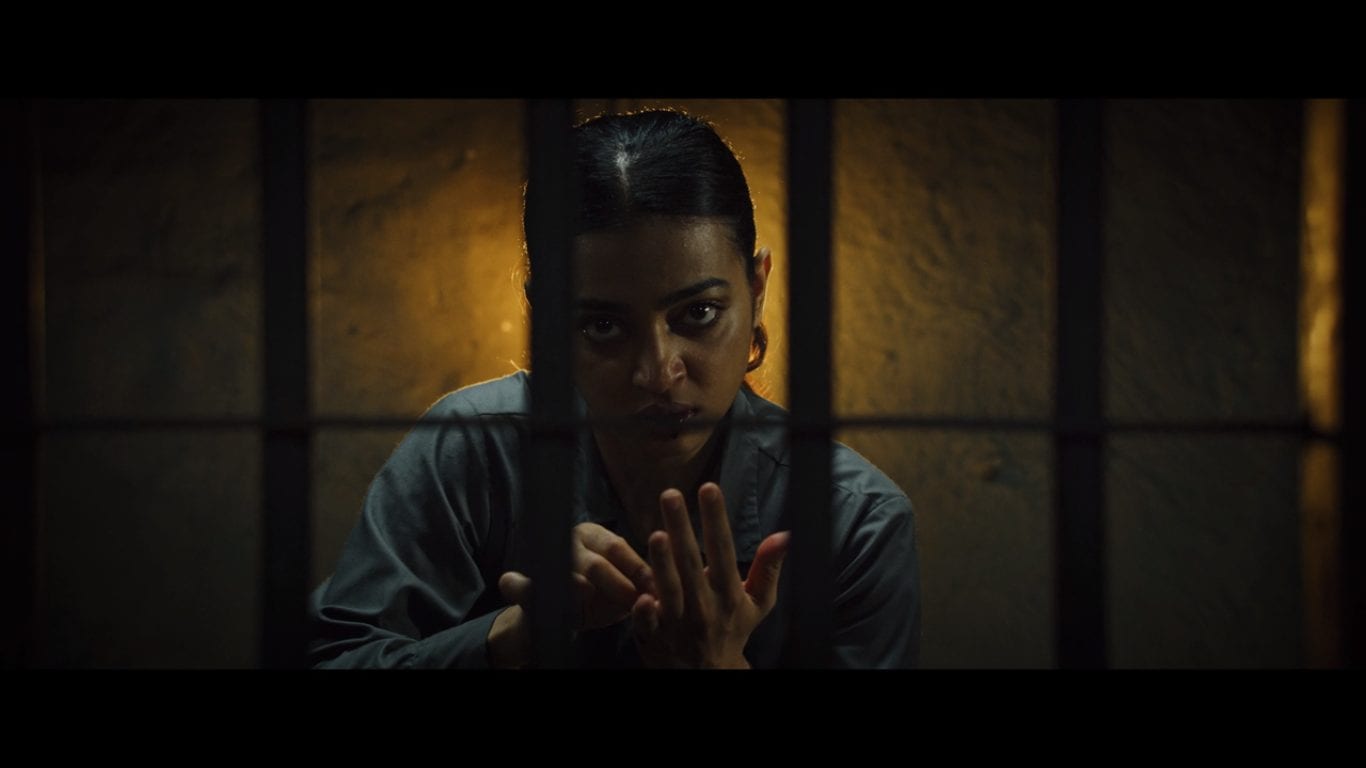Now, this is the show I thought I was going to get from minute one. The third and final part of Ghoul brings the tension, horror and bloodshed I was waiting to see, and even further enhances the parallels between it and The Thing. We already knew the characters in Ghoul weren’t to be trusted and everyone had their own agenda, but this final episode reveals the truths and circumstances surrounding everything that has happened at Meghdoot 31. Though, there aren’t many people left when all is said and done, as Ghoul takes the body count to the extreme, leaving no prisoners (both figuratively and literally) behind. We open with the arrival of Faulad Singh, who viciously tortures Saeed after the guards leave their positions to let him do his job. While that is happening, Nida questions Maulvi about the truth surrounding Saeed, and he reveals the Ghoul’s origin. The seeker of the Ghoul can summon the demon by making a sign with their blood and surrendering their soul.
The Ghoul preys on its victims and uses their guilt against them (like the nightmares), before destroying them and everything in its path. After it has tasted the flesh of its victim, the Ghoul takes on their appearance (like the Thing) and uses it as a weapon. Again, The Thing comparisons are very obvious and while it’s beginning to feel a bit like a miniseries version of that story, enough is being done with Ghoul to make it stand on its own. After all, The Thing is a great story that has influenced countless others over the years, so if Patrick Graham was inspired by that tale and added his own political edge, I think he has made the smart choice by making Ghoul different enough to be rewarding in its own right. We cut to Dacunha on the phone, and he is told Saeed’s partially eaten body has been found elsewhere, meaning the man they are torturing isn’t a man at all. We knew that, of course, but this is the first time Dacunha starts to believe it after being warned by Nida in the previous episode.

The aftermath of the Ghoul’s off-screen devouring of Faulad Singh is quite something indeed, as we see his bloodied body chained up while his severed head is, well, severed. The Ghoul now takes on the form of Faulad Singh and unlocks the cages containing the prisoners. An incredibly tense chase scene then follows, which sees Nida saved just in time. As usual, Major Das refuses to believe Nida’s story about the Ghoul, so she has her arrested and locked away for believing she’s a traitor conspiring against the NPS. The next scene is perhaps the most like The Thing yet, as the prisoners and Nida soon realise the Ghoul has taken on another form and is therefore inside the chamber. But who is it now? First, Nida finds out the truth about Meghdoot 31, which is basically a prison from which there’s no return. You’re sent there to be killed, and she soon realises the fate of her father, who had been sent there previously. Again, we already knew about this, but Nida had been playing catch up until now.
We were always one step ahead of Nida and she will soon be level with us and on the same page, but first, she must figure out who summoned the monster in the first place. She hears about how one of the prisoners, Ahmed, is totally innocent and lost his voice after his wife and child were murdered in front of him by Chaudhary (as referenced during the dream sequence conversation in the last episode). Nida also realises what her actions have done to her father, and how she unknowingly played a part in his death by execution. The world of Ghoul is a ruthless place where the government-formed NPS has taken their position to the extreme, enacting heinous crimes against the innocent and brainwashing those vulnerable enough to believe in their authoritarian madness. It doesn’t really matter who’s to blame for the death of Shahnawaz or the others, though, as they shouldn’t have been killed anyway. He was innocent—like many before him—and the NPS knows what they’re doing.

The prisoners then decide to lock themselves in the room as protection, but one of them is already dead and the Ghoul has taken on their likeness à la The Thing. The Ghoul doesn’t take long to manifest itself, though, as the hungry demon kills many of the prisoners in quick succession. Nida and Ahmed manage to escape, but she has been bitten and the Ghoul takes on her identity. The Ghoul saves the innocent Ahmed while the real Nida returns to the soldiers, and she is beaten by Major Das who still believes her to be a terrorist. A fight breaks out among the soldiers, and it’s revealed that Nida was transferred to Meghdoot 31 because Ali Saeed mentioned her name upon capture (as seen but not heard at the beginning of the miniseries). Major Das tries to stab Nida in the back, but Dacunha shoots and kills her before she has the chance. Dacunha then tells Nida about her father’s interrogation and exposes Shahnawaz as the one who summoned the Ghoul (again, as seen in the first episode).
Everything in Ghoul has happened for a reason, suddenly all the jigsaw pieces are falling into place, and it’s all beginning to make sense. The government is responsible for everything. All the lies, the secrets, the death and destruction of a nation. Shahnawaz summoned the Ghoul to show Nida the real truth about the NPS and expose their fascist atrocities before it was too late to save her. The final act of an innocent man who wanted to see the NPS get a taste of their own medicine. Presumably, this is how the Ghoul/Saeed knew Nida’s nickname in the previous episode, too. Dacunha heard the words Shahnawaz repeated over and over to summon the Ghoul but decided to ignore them as he wasn’t sure of what he was doing. Nida remembers her father’s words and how he was right about what is happening, “This false sense of patriotism that seems to be spreading through the country.” After, Nida and Dacunha go looking for Ahmed and an escape route from the hellhole that is Meghdoot 31.

With guns cocked and loaded, Nida and Dacunha pass through halls and rooms sprayed with blood and dead bodies, preparing themselves to take down the Ghoul. They force their way into a room containing the only remaining people alive, and all the soldiers are blaming Ahmed for the killings. Nida tells them of the Ghoul’s ways and warns them to keep a close eye on one another while waiting for the arrival of reinforcement. She then asks Ahmed the find the recording of Shahnawaz’s interrogation so she can hear the truth for herself. “The Ghul will come. My betrayer…my daughter Nidu…will bear witness. She will learn…and so will all of you…from this sin…that you are all knowingly committing,” says Shahnawaz, who was then taken to the execution chamber even after Dacunha denounced him as nothing more than a confused old man. Things are only going getting worse for Nida, as revelation after revelation exposes the lies she has believed and the mistakes she has made.
She realises that the Ghoul was summoned by her father to teach her a lesson, and now she finally sees the light at the end of the tunnel (before she actually shoots the lights out to discover who the Ghoul is inhabiting). Things happen very quickly during the last 10 minutes of the show, as the Ghoul emerges in the darkness, while gunfire is providing our only source of light in a scene in which the chaos is perfectly designed and edited. We can hear the Ghoul preying on its victims and see the reckless loss of life caused by wayward shooting, but Nida has other things in mind. She shoots through the blacked out glass window and makes her escape with Ahmed, while the Ghoul prepares to take Dacunha as its last victim. That is until he sets off a grenade in the hopes of killing the demon before he emerges unharmed from the explosion. Unbeknown to Nida, the facility is already surrounded by a recovery unit, who are armed and ready to pounce when she hostilely pulls a shotgun on Dacunha.

Obviously, Nida knows it’s impossible for Dacunha to have survived the blast, so she kills him and the Ghoul that possibly resides within him, despite Dacunha’s failed attempts to convince her otherwise. Even if Dacunha was telling the truth and had, in fact, killed the Ghoul while he hid from the blast, his depravities have caused people enough pain, which left Nida with no other choice but to kill whichever sinner knelt before her (be it man or monster). Nida is then detained by the recovery team, and we’re shown a dream sequence of a happy Nida and Shahnawaz, living a life uninterrupted by the monstrous activities of the government. The final scenes see Nida being interrogated and locked away for the murder of Col. Dacunha, as she accepts the corruptions she allowed into her life. The government is the real enemy here, but Nida is the one who is being punished. Though, while in jail, Nida prepares her revenge by summoning the Ghoul once again as we cut to black. The end.
It might just be me, but I feel like we needed that moment of catharsis, as Nida looks directly into the camera after pulling a razor out of her bloody mouth. A fourth wall-breaking wink that lets us know that although she may be the one who is locked away, she is the one who holds all the power and now knows how to summon the demon known as the Ghoul. A great ending in my opinion, and one that leaves me both clamouring for more and happy if this is all the Ghoul we get. And, so ends the three-part miniseries that is Ghoul. I really love how the final episode didn’t skimp on the violence and left us with an ending that is both satisfyingly finite and rewarding, all while leaving enough room for further episodes should Patrick Graham and Netflix ever choose to make them. The miniseries works perfectly as is, though, as it’s a self-contained and structurally familiar story that doesn’t get overly ambitious with its narrative, which is often the downfall of many a miniseries. Nice work, Netflix.

If the political commentary of The Handmaid’s Tale meets atmospheric depravity of The Thing sounds like your cup of tea, well, I don’t think you could find a politically aware horror miniseries that much better than Ghoul. I know I’ll be summoning the Ghoul a few more times in the near future. I think I’ll skip that blood offering part, though. Surely there must be an easier way?
So, what are your thoughts on the entirety of Ghoul? Did Patrick Graham and Netflix do the right thing by splitting the film into a three-part miniseries, or do you think would you have enjoyed it more if it had been left alone in its original state? Please leave a comment and let us know by following the information about our social media accounts, which can be found below. Alternatively, you can follow me on Twitter (@JonSheasby), and we’ll continue the conversation over there.
Looking for more on Ghoul? We’ve got you:
Ghoul: A Netflix Original Miniseries – “Out of the Smokeless Fire”
Ghoul: A Netflix Original Miniseries – “The Nightmares Will Begin”



